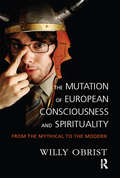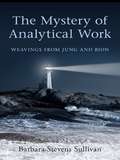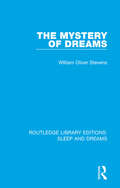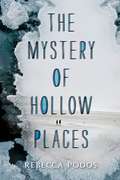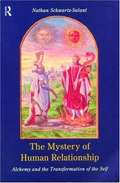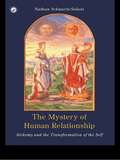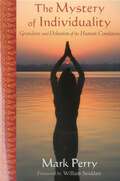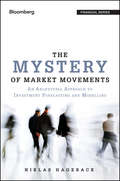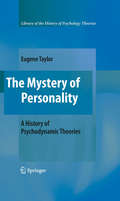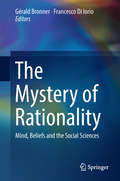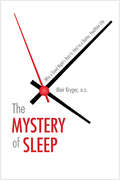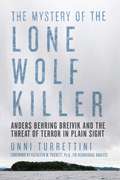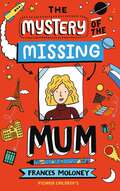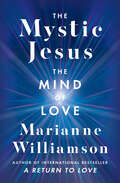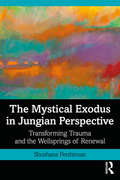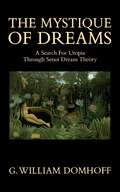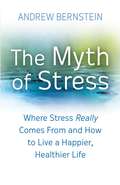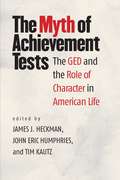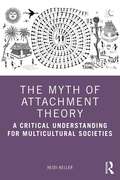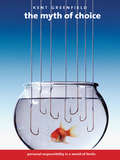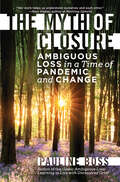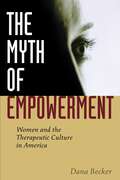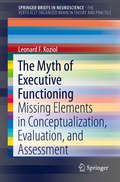- Table View
- List View
The Mutation of European Consciousness and Spirituality: From the Mythical to the Modern
by Willy ObristFrom the early 1970s, the author worked on the neglected theory of C.G. Jung's depth psychology, incorporating it into modern knowledge about living organisms, and reflecting on the consequences of Jung's discovery for our worldview and religion. What is new about the present study is that the author approaches the religious metamorphosis from the perspective of the evolution of consciousness itself. The result of his exploration made the author realize that the development of European consciousness was not just an accidental historical process but a true evolutionary step: a "mega mutation" of consciousness. In this process, the basic parameter of the mythical understanding of our world was overcome and replaced by a completely new worldview which - after the discovery of the unconsious by Freud and Jung - was founded on scientific results empirically proved. This enables humanity to transcend the dilemma between knowledge and faith and to find a new understanding of both matter and mind that is adequate to today's knowledge of nature. From this point of view, a radically new access to spirituality and ethics becomes possible.
The Mystery of Analytical Work: Weavings from Jung and Bion
by Barbara Stevens SullivanThis book provides an exploration of the clinical practice of psychoanalysis and analytical psychology. It explores the ways psychoanalysts and other clinicians are taught to evade direct emotional connections with their patients. Sullivan, suggesting that relatedness is the basis of emotional health, examines the universal struggle between socially oriented energies that struggle toward truth and narcissistic impulses that push us to take refuge in lies. She maintains that, rather than making interpretations, it is the clinician’s capacity to bring relatedness to the clinical encounter which is the crucial factor. Examining the work of both Jung and Bion, Sullivan draws on the overlap between their ideas on the psyche and the nature of the unconscious. The book uses clinical examples to examine the implications that these perspectives have for the practising therapist. Specific areas of discussion include: the creative unconscious the structure of narcissism transformation in analytic work. New modes of listening and relating that deepen analytic work and greatly facilitate transformative changes are described in easy-to-follow language that will help the therapist to find new approaches to a wide range of patients. The Mystery of Analytical Work will be of interest to Jungians, psychoanalysts and all those with an interest in analytic work.
The Mystery of Courage
by William Ian MillerFew of us spend much time thinking about courage, but we know it when we see it--or do we? Is it best displayed by marching into danger, making the charge, or by resisting, enduring without complaint? Is it physical or moral, or both? Is it fearless, or does it involve subduing fear? Abner Small, a Civil War soldier, was puzzled by what he called the "mystery of bravery"; to him, courage and cowardice seemed strangely divorced from character and will. It is this mystery, just as puzzling in our day, that William Ian Miller unravels in this engrossing meditation. Miller culls sources as varied as soldiers' memoirs, heroic and romantic literature, and philosophical discussions to get to the heart of courage--and to expose its role in generating the central anxieties of masculinity and manhood. He probes the link between courage and fear, and explores the connection between bravery and seemingly related states: rashness, stubbornness, madness, cruelty, fury; pride and fear of disgrace; and the authority and experience that minimize fear. By turns witty and moving, inquisitive and critical, his inquiry takes us from ancient Greece to medieval Europe, to the American Civil War, to the Great War and Vietnam, with sidetrips to the schoolyard, the bedroom, and the restaurant. Whether consulting Aristotle or private soldiers, Miller elicits consistently compelling insights into a condition as endlessly interesting as it is elusive.
The Mystery of Dreams (Routledge Library Editions: Sleep and Dreams #8)
by William Oliver StevensOriginally published in 1950, this title includes instances of dreams in published records from both British and American societies of psychical research, covering six decades. This work had been previously inaccessible to the ordinary reader. Other stories have come from friends and acquaintances of the author and in his introduction he states that: ‘the chief purpose of this collection is to present examples of apparently significant dreams, those that "come true", there will be no effort in these pages to debate possible explanations based on known laws, either of chance or of psychology. Readers are able to exercise their own ingenuity to this end. The material is offered here simply as evidence of a striking phenomenon in human consciousness, which, instead of being brushed aside as superstition, calls for serious study. It may have a profound bearing on the riddle of human personality.’
The Mystery of Hollow Places
by Rebecca PodosThe Mystery of Hollow Places is a gorgeously written, stunningly original novel of love, loss, and identity, from debut author Rebecca Podos.All Imogene Scott knows of her mother is the bedtime story her father told her as a child. It's the story of how her parents met: he, a forensic pathologist; she, a mysterious woman who came to identify a body. A woman who left Imogene and her father when she was a baby, a woman who was always possessed of a powerful loneliness, a woman who many referred to as "troubled waters."Now Imogene is seventeen, and her father, a famous author of medical mysteries, has struck out in the middle of the night and hasn't come back. Neither Imogene's stepmother nor the police know where he could've gone, but Imogene is convinced he's looking for her mother. And she decides it's up to her to put to use the skills she's gleaned from a lifetime of reading her father's books to track down a woman she's only known in stories in order to find him and, perhaps, the answer to the question she's carried with her for her entire life.
The Mystery of Human Relationship: Alchemy and the Transformation of the Self
by Nathan Schwartz-SalantBy analogy with the ancient system of alchemy, Jungian analyst Nathan Schwartz-Salant shows how states of mind can undermine our relationships both private and public, but when brought to consciousness can become positive factors.
The Mystery of Human Relationship: Alchemy and the Transformation of the Self
by Nathan Schwartz-SalantAll human relationships are containers of emotional life, but what are the structures underlying them? Nathan Schwartz-Salant looks at all kinds of relationships through an analyst's eye. By analogy with the ancient system of alchemy he shows how states of mind that can undermine our relationships - in marriage, in creative work, in the workplace - can become transformative when brought to consciousness. It is only by learning how to access the interactive field of our relationships that we can enter this transformative process and explore its mysterious potential for self-realization.
The Mystery of Individuality: Grandeur and Delusion of the Human Condition
by Mark PerryThe Mystery of Individuality explores the nature of human individuality through twelve chapter-mirrors, whose main focal points are spirituality, psychology, sociology, and love, and also the meaning of sacred art. The issues of leadership and justice, as well as of politics, and even crime, are also examined in depth, along with the roles of sexuality and marriage. Finally, man and woman are defined in the context of both cosmology and society, with a special emphasis on the divine nature of a human being and what this entails morally and socially. Perry bases his assessments on the guiding image of archetypal man, namely of a being created in the image of God. At the same time, he does not shy away from addressing what the distortion of this archetype entails. He asserts that in creating man, God lent him his own immortal personhood, namely all that we find most lovable in another human creature, in other words his personality. But finally the question for each of us comes down to remembering our divine essence without forgetting our human nothingness.
The Mystery of Market Movements
by Niklas HagebackA quantifiable framework for unlocking the unconscious forces that shape marketsThere has long been a notion that subliminal forces play a great part in causing the seemingly irrational financial bubbles, which conventional economic theory, again and again, fails to explain. However, these forces, sometimes labeled 'animal spirits' or 'irrational exuberance, have remained elusive - until now. The Mystery of Market Movements provides you with a methodology to timely predict and profit from changes in human investment behaviour based on the workings of the collective unconscious.Niklas Hageback draws in on one of psychology's most influential ideas - archetypes - to explain how they form investor's perceptions and can be predicted and turned into profit. The Mystery of Market Movements provides;A review of the collective unconscious and its archetypes based on Carl Jung's theories and empirical case studies that highlights and assesses the influences of the collective unconscious on financial bubbles and zeitgeistsFor the first time being able to objectively measure the impact of archetypal forces on human thoughts and behaviour with a view to provide early warning signals on major turns in the markets. This is done through a step-by-step guide on how to develop a measurement methodology based on an analysis of the language of the unconscious; figurative speech such as metaphors and symbolism, drawn out and deciphered from Big Data sources, allowing for quantification into time seriesThe book is supplemented with an online resource that presents continuously updated bespoken archetypal indexes with predictive capabilities to major financial indexesInvestors are often unaware of the real reasons behind their own financial decisions. This book explains why psychological drivers in the collective unconscious dictates not only investment behaviour but also political, cultural and social trends. Understanding these forces allows you to stay ahead of the curve and profit from market tendencies that more traditional methods completely overlook.
The Mystery of Personality
by Eugene TaylorIn The Mystery of Personality: A History of Psychodynamic Theories, acclaimed professor and historian Eugene Taylor synthesizes the field's first century and a half into a rich, highly readable account. Taylor situates the dynamic school in its catalytic place in history, re-evaluating misunderstood figures and events, re-creating the heady milieu of discovery as the concept of "mental science" dawns across Europe, revisiting the widening rift between clinical and experimental study (or the couch and the lab) as early psychology matured into legitimate science. Gradual but vital evolutions form the heart of this chronicle: the ebb and flow of analytic theory and practice, the shift from doctor-centered to client-centered therapy, the movement from exclusionary to multidisciplinary, the evolving role of the therapist. And as can be expected from the author, there is special emphasis on the sublime in psychology: the philosophy/psychology fusion of the New England transcendentalists, the battle between spiritualism and science in 1880s America, and early versions of today's spiritually-attuned therapies. Pivotal concepts and key individuals covered are: Charcot, Janet, and the origins of dynamic personality theory in the so-called French, Swiss, English, and American psychotherapeutic axis. Person and personality: William James's "radical empiricism" The rise of psychoanalysis: Freud, the Freudians, and the Neo-Freudians Adler and Jung, who were never "students" of Freud: Toward, within, and beyond the self Murray, Allport, and Lewin at Harvard in the 30s Culture and personality, pastoral counseling, and Gestalt Psychology in New York in the '40s and '50s An Existential-humanistic and Transpersonally oriented depth psychology in the 60s The current era: "science confronts itself", as neuroscience enters the picture. Students of psychology and its history will find in this inspiring narrative both possibilities for further study and a new appreciation of their own work. The Mystery of Personality: A History of Psychodynamic Theories is a stimulating course conducted by a master teacher.
The Mystery of Rationality: Mind, Beliefs and the Social Sciences (Lecture Notes in Morphogenesis)
by Gérald Bronner Francesco Di IorioThis book contributes to the developing dialogue between cognitive science and social sciences. It focuses on a central issue in both fields, i.e. the nature and the limitations of the rationality of beliefs and action. The development of cognitive science is one of the most important and fascinating intellectual advances of recent decades, and social scientists are paying increasing attention to the findings of this new branch of science that forces us to consider many classical issues related to epistemology and philosophy of action in a new light. Analysis of the concept of rationality is a leitmotiv in the history of the social sciences and has involved endless disputes. Since it is difficult to give a precise definition of this concept, and there is a lack of agreement about its meaning, it is possible to say that there is a ‘mystery of rationality’. What is it to be rational? Is rationality merely instrumental or does it also involve the endorsement of values, i.e. the choice of goals? Should we consider rationality to be a normative principle or a descriptive one? Can rationality be only Cartesian or can it also be argumentative? Is rationality a conscious skill or a partly tacit one? This book, which has been written by an outstanding collection of authors, including both philosophers and social scientists, tries to make a useful contribution to the debates on these problems and shed some light on the mystery of rationality. The target audience primarily comprises researchers and experts in the field.
The Mystery of Sleep: Why a Good Night's Rest Is Vital to a Better, Healthier Life
by Meir KrygerAn authoritative and accessible guide to what happens when we shut our eyes at night We spend a third of our lives in bed, but how much do we really understand about how sleep affects us? In the past forty years, scientists have discovered that our sleep (or lack of it) can affect nearly every aspect of our waking lives. Poor sleep could be a sign of a disease, the result of a vitamin or iron deficiency, or the cause of numerous other problems, both sleeping and waking. Yet many people, even medical personnel, are unaware of the dangers of poor sleep. Enter Dr. Meir Kryger, a world authority on the science of sleep, with a comprehensive guide to the mysteries of slumber that combines detailed case studies, helpful tables, illustrations, and pragmatic advice. Everyone needs a good night's sleep, and many of us will experience some difficulty sleeping or staying awake over the course of our lifetimes (or know someone who does). Kryger's comprehensive text is a much-needed resource for insomniacs; for those who snore, can't stay awake, or experience disturbing dreams; and for the simply curious. Uniquely wide ranging, The Mystery of Sleep is more than a handbook; it is a guide to the world of sleep and the mysterious disorders that affect it.
The Mystery of the Lone Wolf Killer: Anders Behring Breivik and the Threat of Terror in Plain Sight
by Kathleen M. Puckett Unni Turrettini<P>For the first time, the life and mind of Anders Behring Breivik, the most unexpected of mass murderers, is examined and set in the context of wider criminal psychology. <P>July 22, 2011 was the darkest day in Norway's history since Nazi Germany's invasion. It was one hundred eighty-nine minutes of terror--from the moment the bomb exploded outside a government building until Anders Behring Breivik was apprehended by the police at Utoya Island. Breivik murdered seventy-seven people, most of them teenagers and young adults, and wounded hundreds more. The massacre left the world in shock. <P>Breivik is a new type of mass murderer, and he is not alone. Indeed, he is the archetypal "lone wolf killer," often overlooked until the moment they commit their crime. He has inspired others like him, just as Breivik was inspired by Timothy McVeigh and Theodore Kaczynski. No other killer has murdered more people single-handedly in one day. Adam Lanza studied Breivik's now infamous manifesto prior to his own unthinkable crime. Breivik was Lanza's role model, as he will no doubt be for others in the future who are frustrated with their societies, and most of all, their lives. <P>Breivik is also unique as he is the only "lone wolf" killer in recent history to still be alive and in captivity. With unparalleled research and a unique international perspective, The Mystery of the Lone Wolf Killer examines the massacre itself and why this lone-killer phenomenon is increasing worldwide.
The Mystery of the Missing Mum
by Frances MoloneyAn anxious boy searches for his missing mum in this heartfelt, funny and unique ode to perfectly imperfect familiesOne day, Jake wakes up to a different world: his mum seems to have vanished into thin air! With his Grandma snoring in the kitchen and older sister Rose spending hours getting ready, Jake starts the search for his mum by making a list of places she might be: Tesco? The EU? Hospital? The Bahamas? Being a detective turns out to be quite hard work and everyone Jake turns to for help seems frustratingly busy. Life at home wasn't perfect, but he can't understand why she would simply run off like this. And why doesn't everyone else seem more concerned?
The Mystery of the Ultimatum Game: Why We Are Predictably Irrational
by Kayoko KobayashiThis ambitious book is the first to present a theoretical framework for a unified analysis of both behavioral and traditional economics. It explores the ultimate factors from an evolutionary perspective in addressing why humans are predictably irrational and proposes "adaptive rationality," a new direction for understanding human behavior. Taking anomalies in ultimatum game experiments as a starting point, this book presents findings from hundreds of experiments. The interdisciplinary nature of the book, which encompasses the latest research across an astonishingly wide range of fields—including game theory, psychology, neuroscience, cognitive science, cultural anthropology, biology, and ethology—provides boundless intellectual excitement. While this is an academic book discussing human rationality, it can also be seen as a popular science book that delves deeply into questions such as "What underlies human decision making?" The book stands out for its unique approach, making it an unparalleled reading experience. The original Japanese edition won the Nikkei Prize for Economics Books (the 64th Nikkei-Keizai Tosho Bunka award) in 2021, an accolade bestowed upon an outstanding economics book published in a given year. Furthermore, this edition also received the Takashima Kunio Jiyu Prize Encouragement Award in 2024.
The Mystic Jesus: The Mind of Love (The Marianne Williamson Series)
by Marianne WilliamsonReturning to the topic of her beloved classic bestseller A Return to Love, spiritual guide Marianne Williamson builds on the ideas introduced in that book to lead us toward the light through the inspiring guidance of the mystic Jesus.In A Return to Love: Reflections on the Principles of A Course in Miracles, Marianne Williamson revealed how we each become miracle-workers when expressing love and forgiveness in our everyday lives. With The Mystic Jesus, Williamson reveals the role of Jesus in the teachings of the Course. For many, Jesus has become a precious relic, revered yet lacking the immediacy of authentic spiritual force. In The Mystic Jesus, Williamson writes of a Jesus who transcends both glib imagery and outdated religious dogma. She writes not only of an historical Messiah but of a spirit alive in all of us today.Williamson brings to The Mystic Jesus her talent at making the densest theological theories relevant to our everyday lives. She merges psychological and religious understanding, presenting Jesus as a guide to another way of thinking, therefore the builder of another kind of world. The Jesus in The Mystic Jesus truly is, in the words of St. Augustine, “ever ancient, ever new.”The Jesus presented here is a radical love, an ever-present teacher, an evolutionary elder brother, and a savior from the fear-based, twisted thinking that dominates our world. The Mystic Jesus is both theological and practical, signature Williamson in both its intellectual clarity and emotional impact.
The Mystical Exodus in Jungian Perspective: Transforming Trauma and the Wellsprings of Renewal
by Shoshana FershtmanThe Mystical Exodus in Jungian Perspective explores the soul loss that results from personal, collective, and transgenerational trauma and the healing that unfolds through reconnection with the sacred. Personal narratives of disconnection from and reconnection to Jewish collective memory are illuminated by millennia of Jewish mystical wisdom, contemporary Jewish Renewal and feminist theology, and Jungian and trauma theory. The archetypal resonance of the Exodus story guides our exploration. Understanding exile as disconnection from the Divine Self, we follow Moses, keeper of the spiritual fire, and Serach bat Asher, preserver of ancestral memory. We encounter the depths with Joseph, touch collective grief with Lilith, experience the Red Sea crossing and Miriam’s well as psychological rebirth and Sinai as the repatterning of traumatized consciousness. Tracing the reawakening of the qualities of eros and relatedness on the journey out of exile, the book demonstrates how restoring and deepening relationship with the Sacred Feminine helps us to transform collective trauma. This text will be key reading for scholars of Jewish studies, Jungian and post-Jungian studies, feminist spirituality, trauma studies, Jungian analysts and psychotherapists, and those interested in healing from personal and collective trauma.
The Mystique of Dreams: A Search for Utopia Through Senoi Dream Theory
by G. William DomhoffA fascinating strand of the human potential movement of the 1960s involved the dream mystique of a previously unknown Malaysian tribe, the Senoi, first brought to the attention of the Western world by adventurer-anthropologist-psychologist Kilton Stewart. Exploring the origin, attraction, and efficacy of the Senoi ideas, G. William Domhoff also investigates current research on dreams and concludes that the story of Senoi dream theory tells us more about certain aspects of American culture than it does about this distant tribe. In analyzing its mystical appeal, he comes to some unexpected conclusions about American spirituality and practicality.
The Myth Of Stress: Where stress really comes from and how to live a happier, healthier life
by Andrew J. BernsteinAndrew J Bernstein reveals the truth about stress - where it really comes from, why we've misunderstood it, and a new, more effective way to eliminate it at its source. He argues that the issues that stress people out differ, but that the basic dynamics of stress do not. Yet these have been misunderstood for more than half a century. As a result, almost everyone is confused about where stress actually comes from, with disastrous consequences affecting our health, happiness and our ability to handle change. In this book, he argues that stress is not a physical process with a psychological component, as previously believed, but a psychological process with a physical component. In other words, stress doesn't come from what is going on in your life - it comes from your thoughts about what is going on in your life. Your job isn't stressful,for example, it's your thoughts about your job that are stressful and so on. All stress is an inside job, a result of subconscious assumptions. By using the specially developed techniques in this book and by addressing stress at its source, there is nothing you can't transform.
The Myth of Achievement Tests: The GED and the Role of Character in American Life
by James J. Heckman John Eric Humphries Tim KautzAchievement tests play an important role in modern societies. They are used to evaluate schools, to assign students to tracks within schools, and to identify weaknesses in student knowledge. The GED is an achievement test used to grant the status of high school graduate to anyone who passes it. GED recipients currently account for 12 percent of all high school credentials issued each year in the United States. But do achievement tests predict success in life? "The Myth of Achievement Tests" shows that achievement tests like the GED fail to measure important life skills. James J. Heckman, John Eric Humphries, Tim Kautz, and a group of scholars offer an in-depth exploration of how the GED came to be used throughout the United States and why our reliance on it is dangerous. Drawing on decades of research, the authors show that, while GED recipients score as well on achievement tests as high school graduates who do not enroll in college, high school graduates vastly outperform GED recipients in terms of their earnings, employment opportunities, educational attainment, and health. The authors show that the differences in success between GED recipients and high school graduates are driven by character skills. Achievement tests like the GED do not adequately capture character skills like conscientiousness, perseverance, sociability, and curiosity. These skills are important in predicting a variety of life outcomes. They can be measured, and they can be taught. aUsing the GED as a case study," "the authors explore what achievement tests miss and show the dangers of an educational system based on them. They call for a return to an emphasis on character in our schools, our systems of accountability, and our national dialogue. ContributorsEric Grodsky, University of WisconsinOCoMadisonAndrew Halpern-Manners, Indiana University BloomingtonPaul A. LaFontaine, Federal Communications CommissionJanice H. Laurence, Temple UniversityLois M. Quinn, University of WisconsinOCoMilwaukeePedro L. Rodr guez, Institute of Advanced Studies in AdministrationJohn Robert Warren, University of Minnesota, Twin Cities
The Myth of Attachment Theory: A Critical Understanding for Multicultural Societies
by Heidi KellerThe Myth of Attachment Theory confronts the uncritical acceptance of attachment theory – challenging its scientific basis and questioning the relevance in our modern, superdiverse and multicultural society – and exploring the central concern of how children, and their way of forming relationships, differ from each other. In this book, Heidi Keller examines diverse multicultural societies, proposing that a single doctrine cannot best serve all children and families. Drawing on cultural, psychological and anthropological research, this challenging volume respects cultural diversity as the human condition and demonstrates how the wide heterogeneity of children’s worlds must be taken seriously to avoid painful or unethical consequences that might result from the application of attachment theory in different fields. The book explores attachment theory as a scientific construct, deals with attachment theory as the foundation of early education, specifies the dimensions that need to be considered for a culturally conscious approach and, finally, approaches ethical problems which result from the universality claim of attachment theory in different areas. This book employs multiple and mixed methods, while also going beyond critical analysis of theory to offer insight into the implications of the unquestioning acceptance of this theory in such areas as childhood interventions, diagnosis of attachment security, international intervention programs and educational settings. This volume will be a crucial read for scholars and researchers in developmental, educational and clinical psychology, as well as educators, teachers-in-training and other professionals working with children and their families.
The Myth of Choice
by Kent GreenfieldAmericans are fixated on the idea of choice. Our political theory is based on the consent of the governed. Our legal system is built upon the argument that people freely make choices and bear responsibility for them. And what slogan could better express the heart of our consumer culture than "Have it your way"? In this provocative book, Kent Greenfield poses unsettling questions about the choices we make. What if they are more constrained and limited than we like to think? If we have less free will than we realize, what are the implications for us as individuals and for our society? To uncover the answers, Greenfield taps into scholarship on topics ranging from brain science to economics, political theory to sociology. His discoveries--told through an entertaining array of news events, personal anecdotes, crime stories, and legal decisions--confirm that many factors, conscious and unconscious, limit our free will. Worse, by failing to perceive them we leave ourselves open to manipulation. But Greenfield offers useful suggestions to help us become better decision makers as individuals, and to ensure that in our laws and public policy we acknowledge the complexity of choice.
The Myth of Closure: Ambiguous Loss in a Time of Pandemic and Change
by Pauline BossHow do we begin to cope with loss that cannot be resolved? The COVID-19 pandemic has left many of us haunted by feelings of anxiety, despair, and even anger. In this book, pioneering therapist Pauline Boss identifies these vague feelings of distress as caused by ambiguous loss, losses that remain unclear and hard to pin down, and thus have no closure. Collectively the world is grieving as the pandemic continues to change our everyday lives. With a loss of trust in the world as a safe place, a loss of certainty about health care, education, employment, lingering anxieties plague many of us, even as parts of the world are opening back up again. Yet after so much loss, our search must be for a sense of meaning, and not something as elusive and impossible as "closure." This book provides many strategies for coping: encouraging us to increase our tolerance of ambiguity and acknowledging our resilience as we express a normal grief, and still look to the future with hope and possibility.
The Myth of Empowerment: Women and the Therapeutic Culture in America
by Dana BeckerThe Myth of Empowerment surveys the ways in which women have been represented and influenced by the rapidly growing therapeutic culture-both popular and professional-from the mid-nineteenth century to the present. The middle-class woman concerned about her health and her ability to care for others in an uncertain world is not as different from her late nineteenth-century white middle-class predecessors as we might imagine. In the nineteenth century she was told that her moral virtue was her power; today, her power is said to reside in her ability to “relate” to others or to take better care of herself so that she can take care of others. Dana Becker argues that ideas like empowerment perpetuate the myth that many of the problems women have are medical rather than societal; personal rather than political.From mesmerism to psychotherapy to the Oprah Winfrey Show, women have gleaned ideas about who they are as psychological beings. Becker questions what women have had to gain from these ideas as she recounts the story of where they have been led and where the therapeutic culture is taking them.
The Myth of Executive Functioning
by Leonard F. KoziolExecutive functioning: we measure it, assess it, document its development in youth, track its decline in age and use it as a basis for diagnoses, treatment planning and-of course-theories. Could it be possible that science has spent decades chasing a cognitive phantom? Noting the lack of consensus concerning definition, component skills, and location within the brain, The Myth of Executive Functioning calls basic assumptions, prominent theories, commonly used test methods, and even the phrase executive functioning into question. The book's deceptively simple argument takes an evolutionary/neuroscience look at the cornerstones of cognitive organization, including memory, planning, decision-making and adaptation to novel circumstances. From there, gaps are identified between systems of cognitive control and those behaviors that are evaluated in neuropsychological testing-gaps that contribute to the disconnect between how science views mind and body, brain and behavior. The author's problem-solving metaphor places new emphasis on stimulus processing and on the relationship between movement and thought as he offers thought-provoking perspectives on: The limits of neuropsychological constructs. The components of adaptive thinking. The automatic aspects of problem solving. The left-brain/right-brain dichotomy. Problems with the domain approach to cognition. New paradigms for testing cognitive functioning. A controversial presentation with the potential to change clinical practice and training, The Myth of Executive Functioning will be read, debated and learned from by neuropsychologists, clinical psychologists, psychiatrists, cognitive neuroscientists and rehabilitation specialists.
